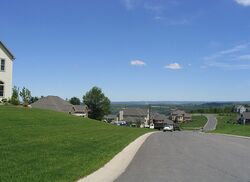Engineering:Street gutter
A street gutter is a depression that runs parallel to a road and is designed to collect rainwater that flows along the street diverting it into a storm drain. A gutter alleviates water buildup on a street, allows pedestrians to pass without walking through puddles, and reduces the risk of hydroplaning by road vehicles. When a curbstone is present, a gutter may be formed by the convergence of the road surface and the vertical face of the sidewalk; otherwise, a dedicated gutter surface made of concrete may be present. Depending on local regulations, a gutter usually discharges, as a nonpoint pollution source in a storm drain whose final discharge falls into a detention pond (in order to remove some pollutants by sedimentation) or into a body of water. Street gutters are most often found in areas of a city which have high pedestrian traffic. In rural areas, gutters are seldom used and are frequently replaced by a borrow ditch.[1]
In past centuries, when urban streets did not have sanitary sewers, street gutters were made deep enough to serve that purpose as well; responsibility for operation and maintenance of the dual-purpose street gutter was cooperatively shared between the local government and the inhabitants.[2]
A now obsolete word meaning a street gutter is a kennel.
See also
- Road debris
- Street sweeper
- Pervious concrete
References
- ↑ Kearfott, Pamela J.; Barrett, Michael E.; Malina, Joseph F. Jr. (May 2005). "Stormwater Quality Documentation of Roadside Shoulders Borrow Ditches". Center for Research in Water Resources, The University of Texas at Austin. https://repositories.lib.utexas.edu/bitstream/handle/2152/6996/crwr_onlinereport05-2.pdf?sequence=2.
- ↑ Jørgensen, Dolly (2008-08-13). "Cooperative Sanitation: Managing Streets and Gutters in Late Medieval England and Scandinavia" (in en). Technology and Culture 49 (3): 547–567. doi:10.1353/tech.0.0047. ISSN 1097-3729. PMID 18831288. http://urn.kb.se/resolve?urn=urn:nbn:se:ltu:diva-5405.
 |



